Five OEMs betting on H2 to power off-highway’s future
24 March 2025
When it comes to powering off-highway equipment, hydrogen fuel (H2) is a bright spot on the horizon. At present, its potential is realized largely via fuel cells. However, hydrogen internal combustion (IC) engines are in development, and the energy-dense fuel could soon find itself replacing diesel to drive equipment with only water vapor for emissions.
H2 ICE Type Approval
On the engine front, JCB in January announced the H2 internal combustion (IC) engine it had been developing had earned type approval for use in commercial equipment — an achievement JCB called a “world first” for construction equipment.
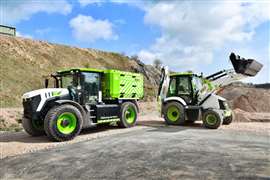 JCB’s hydrogen refueller refuels a hydrogen-powered backhoe loader. (Photo: JCB)
JCB’s hydrogen refueller refuels a hydrogen-powered backhoe loader. (Photo: JCB)
The company said, “Eleven licensing authorities across Europe have now given permission for JCB’s hydrogen engine to be sold — with authorities in other countries set to follow suit with certification in 2025.”
JCB chairman Anthony Bamford called the development very significant for JCB and that it “bodes very well for the future of hydrogen combustion technology.”
The first licensing authority to officially certify JCB’s engine was the Netherlands’ Vehicle Authority RDW. Other European licensing bodies soon followed suit — Belgium, Finland, France, Germany, Great Britain, Poland and Spain among them.
The engine is currently being tested by UK contractor BAM Construction in a Loadall telescopic handler.
“We are proving with our customers that this really can work, that hydrogen can be the future for construction and agricultural equipment, the mobile fuel of the future, and one that is carbon-free, producing nothing but clean steam,” said Tim Burnhope, JCB Group director for special projects.
Additionally, JCB announced in July 2024 it has been developing a hydrogen-fueled generator. Unveiled as a concept at the 2024 Hillhead construction exhibition in the UK, the G60RS H, which is powered by a JCB hydrogen combustion engine, will deliver the same power, performance and efficiency as a diesel-powered unit but with zero emissions, JCB said.
Generating Electric Power
Regarding power generation, UK-based AFC Energy launched its second generation H-Power S+ 200kW generator in February. The unit builds upon the first-gen prototype, which AFC built in partnership with ABB.
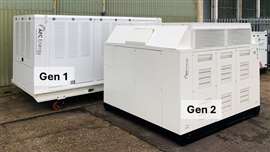 Photo: AFC Energy
Photo: AFC Energy
The gen-set, which has been engineered for applications in construction and off-grid power, now has a 34 percent smaller footprint and 28 percent lighter weight. It also costs about 65 percent less than the first generation unit, AFC said, making it “more portable and cost-effective.”
The new H-Power S+ 200kW generator is slated to power facility operations for Faversham, England-based Brett Aggregates as part of the UK government’s Red Diesel Replacement (RDR) Grant.
In 2023, AFC Energy and UK-based rental firm Speedy Hire launched the 50/50 joint venture Speedy Hydrogen Solutions Ltd (SHS), which is focused on renting hydrogen fuel cell-powered generators.
Off-Highway Lighting
Late last summer, TCP Group, based in Maldon, England, announced it had achieved an operating fleet of 500 fuel cell-powered mobile light towers. The company makes the TCP Ecoline TH200, which was developed in partnership with UK gas provider BOC and is powered by a Hymera fuel cell.
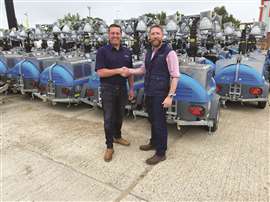 TCP Group sales director Joe Ambor (left) and operations and development director Jim Irvine (right). (Photo: TCP Group)
TCP Group sales director Joe Ambor (left) and operations and development director Jim Irvine (right). (Photo: TCP Group)
Most of the 500 units are available for rent, TCP said, and all have been converted from old diesel-powered units.
“The TCP Ecolite TH200 is an increasingly popular choice where temporary lighting is required as companies look for clean energy solutions to reduce carbon emissions,” said Jim Irvine, operations and development director for TCP.
According to Joe Ambor, sales director for TCP, the company has steadily grown the H2-powered light tower fleet in recent years.
“As a company faithful to recycling where possible, we have remanufactured hundreds of our diesel-powered lighting towers to use hydrogen fuel cells and gas cylinders,” he said.
In addition to the Ecolite TH200, BOC and TCP have also collaborated on other H2-powered light towers towers as well as a range of fuel cell-driven generators.
Extending Equipment Range
According to Benoît Baleydier, project manager at France’s Haulotte, the company decided in 2018 to electrify its machines. In 2021, Haulotte launched its electric HS18 E scissor lift, which had a diesel-powered range extender.
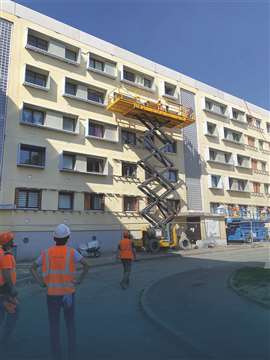 Haulotte’s HS18 E PRO scissor lift. (Photo: Haulotte)
Haulotte’s HS18 E PRO scissor lift. (Photo: Haulotte)
Then in June 2022, Haulotte began its H2 journey when it announced a collaboration with Bouygues Energies & Services, which is a subsidiary of Bouygues Construction that subsequently acquired hydrogen solutions specialist Equans.
As a result of that partnership, Baleydier said the diesel range extender could be replaced with a hydrogen fuel cell version, which is virtually identical in size and power output. The new range extender prototype was used for the first time in October 2024 to support Haulotte’s rough-terrain HS18 E PRO scissor lift at a construction site near Paris.
Equans, which supplied hydrogen to the project, developed a refueling system that doesn’t us an intermediate tank because of regulatory concerns. However, this has made refueling the range extender slow. It will be faster, Baleydier said, once the hydrogen can be pressurized in advance from 200 to 400 bar and stored in an intermediate tank at 350 bar.
“One thing we know is that there will not only be one energy source in the future,” Baleydier said. “We want to be sure we will be ready for the future, so we launched this project to check the regulations, technical issues, and market response.”
Hydrogen Boom Lifts
The HR15E and HR17E boom lifts were launched in June 2023 by Speedy Hire and mobile elevated work platform (MEWP) manufacturer Niftylift. Both companies called the machines a world-first for hydrogen-electric-powered access platforms.
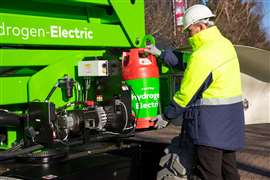 Niftylift’s hydrogen fuel cell-powered boom lift HR15 (Photo: Niftylift)
Niftylift’s hydrogen fuel cell-powered boom lift HR15 (Photo: Niftylift)
Both lifts can operate for up to five days on a single charge, Speedy Hire said. For longer operation, they can rely on the units’ hydrogen fuel cells. And when it comes to refueling, the machines can use a G20 hydrogen cylinder.
Tom Hadden, technical sales manager at Niftylift, said, “Once you’ve depleted the cylinder, you can change it like a gas barbecue.”
He added that refueling with the G20 cylinder requires some training, “but it’s not that you have to do a 10-day course on this. In competency-based training, you can be trained within a morning.”
Making the connections does not require tools, Hadden said. He added that while Niftylift wants to extend its H2-powered product offering this year, there remain challenges to broad adoption the fuel, including a lack of industry standards and few fuel cell suppliers.
POWER SOURCING GUIDE
The trusted reference and buyer’s guide for 83 years
The original “desktop search engine,” guiding nearly 10,000 users in more than 90 countries it is the primary reference for specifications and details on all the components that go into engine systems.
Visit Now
STAY CONNECTED




Receive the information you need when you need it through our world-leading magazines, newsletters and daily briefings.
CONNECT WITH THE TEAM










